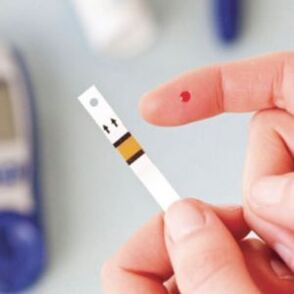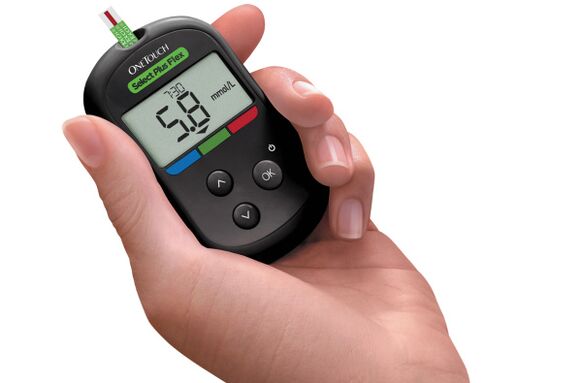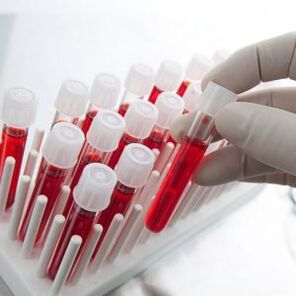
Symptoms of diabetes are a set of clinical manifestations of a specific disease that shows doctors and patients about the onset or progression of the pathological process.
Diabetes mellitus is recognized as one of the most common diseases in the world, today 350 million people worldwide have already been injured. According to statistics, in just two decades, the number of cases has increased by more than 10 times. About 90% of these people - diabetes of the second type.
If you identify the pathology in the initial stages, you can avoid a huge number of severe complications. That is why it is so important to know what indicates the onset of the disease and how a person should be examined to control this severe endocrine pathology.
The manifestations of diabetes do not depend on its type. The human body is able to understand when a sufficient level of energy stops coming from the glucose needed in this case, in the results of a violation of its metabolism and remains in abundance in the blood, which leads to great irreversible damage to the systems and organs. The metabolic processes impaired in the body are provided by a lack of insulin, which is responsible for the process of glucose metabolism. But the characteristics of the pathogenesis of diabetes of the first and second type has significant differences, so it is necessary to know exactly the symptoms of each of them.
The lack of insulin in the blood or reducing the sensitivity of cells dependent on insulin to the action of insulin in the body leads to a high concentration of glucose in the blood. In addition to this symptom, which is considered to be the basic diabetes, there are other signs that are detected during the patient's medical supervision. If the slightest suspicion of the presence of this disease happens, it is worth seeking medical attention, as early open disease is the subject of treatment, and in the modern world, even children at school begin to suffer from diabetes.
As the first manifestations of diabetes, doctors call a number of specific symptoms. In diabetes, patients always have polyuria - rapid and abundant urination due to glycemia and glucose levels in the urine. Glucosuria is the cause that prevents the absorption of fluid from the kidney structures. Polyuria is always accompanied by a thirst in which a person is able to consume up to 10 liters of fluid per day.
Despite the consumption of so many fluids, there is constantly a feeling of dry mouth. In the case of diabetes of the second type, along with the thirst, there is a sense of constant hunger. This is due to the fact that the insulin produced by the pancreas in large quantities circulates in the blood and is not used by its purpose, gives signals to the brain about the feeling of hunger.
The high level of glycemia causes serious damage to the body. Nerve fiber damage leads to diabetic polyneuropathy. The first sign of such a complication is the numbness of the toes and arms and the appearance of severe pain in the limbs. If you start acting at blood glucose levels in a timely manner, the development of this process can also be stopped and the pain syndrome, if you do not stop at all, it will be disturbing not so pronounced. However, if you miss the onset of pathology progression, you can wait for very serious consequences - severe pain, innervation, trophic ulcers and other things.
With damage to the high glycemia of the vessels of the eyes, diabetic angiopathy develops. In the beginning, the disease is manifested by a sensation of a cloud with a high concentration of glucose in the blood, then a decrease in visual acuity and even complete blindness in the absence of therapy is observed. The appearance of any of the above symptoms and, moreover, their complex must force the patient to be urgently examined to detect insulin failure.
Among the external signs are those that indicate the appearance of insulin resistance and high glycemia. For example, such a symptom can be a sharp development of dry skin, itching and peeling. It is especially important to pay attention to such manifestations of the skin against the background of the concomitant thirst. Also, in diabetes, itching is very common on the mucous membrane membranes due to the irritating effect of glucose contained in the urine. At the same time, there is no discard, which is a hallmark of diabetes.
Also, sharp weight loss is a signal for the onset of diabetes of the first type. In this case, it is necessary to observe for some other symptoms of the pathology in order not to make hasty conclusions. Obesity and excessive body weight are not a symptom of diabetes of the second type, but can soon act as its cause. In any case, if a person's weight quickly changes in any direction for no apparent reason, it is worth paying attention to this and being examined by a doctor.
The first type diabetes is very fast in its development. It has its own specific manifestations that must be paid.
The patient has an increased appetite in his history, but he only loses weight, exhausted, suffers from drowsiness. Frequent urges do not allow the toilet at night to sleep peacefully, forcing them to become several times. The amount of urine in this case increases significantly as the feeling of thirst progresses.
Such symptoms cannot go unnoticed as it occurs very abruptly and suddenly. It is accompanied by nausea, vomiting and severe irritability. It is especially important to pay attention to the constant gust of the toilet at night in children, if this has not been observed before.
The main problem with diabetes of the first type is the fact that glucose levels can also increase in the blood and decrease very sharply. Both conditions are dangerous to health and have their own characteristics and manifestations that must be carefully monitored.
The most common is the second type of diabetes. Its manifestations are very diverse, they appear gradually, so it is difficult to immediately catch and recognize them. Mild symptoms usually do not lead to the fact that a person who found it at home begins to sound the alarm immediately.
The second type of diabetes is characterized by the appearance of dry mouth, thirst, abundant urination, weight loss, fatigue, weakness and drowsiness. The characteristic of this variety of the disease in the early stages is the presence of numbness in the fingers and the numbness of the limbs, hypertensive manifestations, the appearance of infectious processes in the urinary system. Similarly, the first type of diabetes of the patient may be impaired by nausea and vomiting, dryness and itching of the skin and skin infections.
It is important to remember that the gradual development of symptoms leads to the development of the disease itself. Diabetes in the short stages is fraught with the onset of hyperosmolar COMLAR, lactoacidosis, ketoacidosis, hypoglycaemia, which become speeds for several hours and can even lead to the patient's death. In addition, as a result of advanced diabetes, patients often have serious vision problems, subsequently lead to complete blindness, renal or heart failure, pathology of the vascular and nervous systems.
Diabetes gestational sugar is rarely manifested by some specific external signs. Most often, its presence is detected with planned examinations that are performed regularly for pregnant women. The main indicators are data from blood and urine tests.
In the presence of external signs of the gestational type of disease, they are all very similar to the symptoms of diabetes of the first two types - nausea, vomiting, weakness, thirst, infection in the geniture are not separate signs of toxicosis and other pathologies, but show in the second and third trimesters of pregnancy for the onset of gestational diabetes.
The gestational form of pathology of the direct threat to the life of a mother or child does not carry, but may affect the overall course of pregnancy, the well -being of the expectant mother and the fetus.
The high blood content of glucose leads to the birth of a baby of high weight (more than 4 pounds), which in the future will be a prerequisite for its obesity or frequency of diabetes at any age. Delaying the development of the child, hypoglycaemia, jaundice at the first pores of the life of the newborn can also manifest itself.
Diabetic leg in medicine is understood as a complete anatomical and functional change in the tissues of the distal parts of the lower limbs in patients with diabetes. This is the most complication of the pathology under consideration, often leading to gangrene, limb amputation and damage.
If there is a history of diabetes in a state of leg health, you should be observed very carefully. There are three main forms of diabetic leg: neuropathic (predominant nerve damage), ischemic (predominant lesion of blood vessels and blood flow disorder) mixed.
Among the complaints of patients preceding the diabetic leg, experts distinguish the unpleasant feelings, burning and sewing sensations in the legs, geese, a feeling of current ejection. If such symptoms disappear when walking, this indicates the beginning of the development of the neuropathic form of the diabetic leg. It is also important to pay attention if the sensitivity disappears periodically. If the painful sensations arise directly when walking or at night (you can only soothe by adapting the limbs from the edge of the bed), this means the beginning of the development of the ischemic form of the diabetic leg called an "ischemic leg".
Among the signs showing the beginning of the development of the diabetic leg, experts distinguish the skin of the skin on the legs or the appearance of pigment spots, peeling and dry skin in this area, the appearance of multicallic bubbles on the skin fractures of small bones on the legs. If a person notices at least a few such signs, he or she must seek medical attention urgently.
Diabetic ophthalmology is manifested by a change in the blood vessels in the retina, which leads to a disruption of the microcirculation in it. Such a disorder leads to diabetic retinopathy. Such a complication develops gradually, and even in the short stages, it can be almost invisible to a person.
The main signs of diabetic retinopathy are:
In this case, diabetic ophthalmology can be manifested through two main forms - no -spheres (background) or retinal proliferative retinal retinal. With background retinopathy, the pathology refers to the first, the retina itself. In the case of disorders in the capillary vessels of the retina, bleeding, retinal swelling and deposition of metabolic products occur. Phone retinopathy is characteristic of elderly patients with diabetes. It causes a gradual decrease in visual acuity.
Based on the background, proliferative retinopathy develops if Osigal maintenance deficiency will increase. In this case, there is a pathological formation of new blood vessels that emerge from the retina in the vitreous. This process leads to bleeding in the vitreous body and a sharp progression of vision of vision in humans and irreversible blindness. In adolescence, such a transition of complications from one form to another can occur in a few months, then there will be a detachment of the retina and complete loss of vision.
Diabetic encephalopathy occurs as a complication of diabetes due to diffuse degenerative damage to the brain. The spread of encephalopathy depends directly on the type of diabetes and its symptoms - on the duration of the disease and its severity. It belongs to late complications and manifests itself 10-15 years after the manifestation of diabetes.
The immediate cause of the development of encephalopathy is the metabolic disorders characteristic of diabetes, which leads to damage to the brain tissues and blood vessels. The above processes lead to impaired brain activity, reducing cognitive function. The development of encephalopathy occurs very slowly, leading to the difficulty in detecting its symptoms in the early stages.
The main symptoms of diabetic encephalopathy are:
In the initial stages, there is virtually no complication of the clinic and with the development of encephalopathy the symptoms begin to appear more clearly. The symptoms are identical to both types of diabetes.
Common diabetes satellite are atherosclerosis, arterial hypertension and obesity. Due to the pride of blood vessels in the case of atherosclerosis, the risk of ischemic strokes and heart attacks increases. In case of impaired microcirculation in the kidney vessels, irreversible renal failure occurs, which ultimately leads to a complete termination of kidney function. This, in turn, leads to the need for replacement therapy with renal failure by the method of dialysis throughout life.
Diabetic coma A diabetic cat means a serious disturbance of the metabolic processes in the body of a patient suffering from diabetes. Coma can occur both with a strong increase and with a severe decrease in human blood sugar.
This condition requires emergency medical care, since in its absence, serious complications and even deaths are possible.
Coma develops in stages, but quite quickly. The first sign of merger, which can be an artistic state, rapid blood sugar growth, nausea and vomiting, drowsiness, abdominal pain per day or more before the immediate coma. Another symptom of diabetic coma may be the acute odor of acetone from the patient's mouth. Sensitivity can also occur in convulsions, thirst, thirst.
With hypoglycemic coma, the blood sugar concentration decreases sharply. The indicator can reach the mark of 2, 5 mmol per liter and below. Among the obvious symptoms of such a coma, unreasonable anxiety, fear of the patient, a feeling of weakness, cramps, fall in blood pressure and loss of consciousness. Precursors of the occurrence of hypoglycemic coma can be:
General malaise; lack of appetite; diarrhea or constipation; Dizziness, headache, tachycardia. Lack of help in this country can have extremely serious consequences. As the hypoglycaemic coma develops rapidly, the assistance provided must be urgent.
The rare decrease in blood pressure in the patient, the weakening of the heart rate and the softness of the eyeball may indicate a sharp decrease in blood pressure. Only a qualified doctor can bring a person to his senses in this condition, so calling the ambulance should follow as soon as possible.
Laboratory You can reliably understand the diagnosis of the patient only after all the necessary laboratory tests. Any laboratory tests for diabetes are aimed at determining blood glucose indicators.
It is possible to accidentally identify blood sugar with mass examinations per person before hospitalization or with an emergency determination of other indicators.
The most common is a blood sugar test on an empty stomach. Nothing can be eaten before delivery for 8-12 hours. Also, you cannot drink alcohol and you cannot smoke an hour before your blood donation. The level of up to 5, 5 mmol per liter will be considered a normal indicator. If the indicator is equal to 7 mmol per liter, the patient will be sent for additional examination. For this purpose, they are tested for glucose tolerance. For this, the patient donates blood on an empty stomach, then drinks a glass of water with sugar (75 grams per adult for 200 milliliters) and 2 hours afterwards he or she diverts a blood test.
If the body is normal, then the first analysis will show the result of up to 5, 5 mmol per liter and the second to 7, 8 mmol per liter. If the indicators are respectively in the range, 5-6. 7 and 7. 8-11. 1 mmol per liter, this will tell the doctors about the development of pre-anthiabeth in the patient. The indicators exceeding these numbers show diabetes.
It is also common to conduct a study of glycated hemoglobin, which demonstrates the average value of human glucose over the last 3 months of life. The norm is the indicator below 5, 7%. If the value is between 5, 7-6, 4%, then this suggests that there is a risk of type 2 diabetes mellitus. In this case, measures should be discussed with the doctor to reduce such a risk. If the level of glycated hemoglobin is more than 6, 5%, the diagnosis of diabetes is likely, but requires confirmation. The recommended level of glycated hemoglobin in people with diabetes is less than 7%, if this level is higher, it is necessary to discuss the situation with your doctor. It should be borne in mind that the level of glycated hemoglobin over 7% can be rated by the doctor as optimal.
Symptoms of a child Diabetes can occur at any age, including early children. Even diabetes of newborns. This is a rare case of a congenital nature of the disease. Most often, the manifestation in children is 6-12 years. The metabolic processes in children during this period continue much faster, and the condition of the indefinite nervous system can affect the level of glucose in the blood. The smaller the baby is, the more complicated the diabetes.
Among the main symptoms that parents should pay attention to in order not to miss the development of diabetes in children, doctors distinguish:
thirst and dry mouth; vomiting nausea; Frequent urination with urine stickiness; Weight loss and high appetite at the same time; decline in visual acuity; High fatigue, weakness and irritability. If the child has at least one of the above symptoms, this is a reason to seek a doctor. If several symptoms are detected, at the same time the doctor should be immediate.
Typical and atypical signs of diabetes may also occur among children. Doctors attribute to the typical symptoms that parents of children often confuse with urinary urinary incontinence, polydipsia, polyfagic, dryness and itching of the skin, itching of the genitals after urination, the amount of blood sugar is more than 5, 5 per liter when tested. Timely diagnosis in the event of suspicion will help identify the disease at an early stage and start the necessary therapy, which will not allow complications to develop.
Determining Diabetes Diabetes at Home The course of diabetes can be absolutely asymptomatic. It can be identified randomly when visiting optometrist or other doctor. However, there are many signs by which the presence of pathology can be assumed independently. In addition, at home, you can determine exactly the type of disease.
With a healthy body, after eating in the blood, sugar levels increase. After 2-3 hours, this indicator should return to its original limits. If this does not happen, then one has a number of symptoms that cannot be noticed. This is already considered dry mouth, thirst, very common and abundant urination, increased appetite, apathy, cramps, nebulae of consciousness. Gradually one begins to notice the dry skin, which has not manifested itself before.
At home, you can suspect the appearance of diabetes of various strange sensations that one has not observed before. In the second type of diabetes, this is a poor healing of wounds and scratches, the development of obesity. In the first type of pathology, a person, on the contrary, can weaken sharply, although the appetite is quite high. Also, in all types of diseases, itching of the skin can occur, increased hair growth of the face, xant formation (small yellow skin growths), hair loss on the limbs and more.
Timely identification of signs of diabetes should cause a doctor.
Only if you begin the therapy for diabetes in the early stages can we hope for compensation for the disease and the normal quality of life in the future.


























